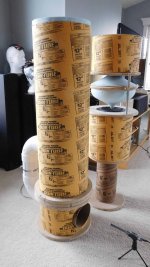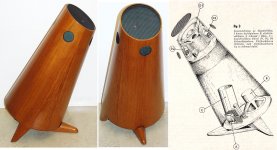Thanks to DonVK for pointing out how Olson make his measurement. I always wondered about that. I think Linkwitz has worked a minor miracle with his Lx Mini design, the imaging on his speaker ranks up there with the best I've ever heard regardless of price, design, room, or whatever. I consider it a benchmark design.
No problem. Olson's experiments are good illustrations, but often don't reflect what designers implement in speaker designs.
BTW I like to build with cylinders, so I have my biases as well.
Box construction is faster, cheaper and easier so it dominates commercial cabinets.
BTW I like to build with cylinders, so I have my biases as well.
Box construction is faster, cheaper and easier so it dominates commercial cabinets.
Attachments
I back your original observations 100%. Of course Olson would choose driver and baffle sizes that most clearly showed the effects of his experiments. The laws of physics do not become obsolete. Apart from the high frequency diffraction problems with drivers mounted in cylinders, there are the internal air resonances. There is a good reason why nearly every wind, brass, percussion instrument I can think of, is to a first approximation, cylindrical in shape. Cylinders are the easiest to support internal air resonances. So in engineering terms, you are making life as difficult as possible by starting with a cylindrical enclosure. It could be argued that the internal resonances of a cylinder are so easy to calculate that they can then be treated with specific damping strategies. Sonus Faber and a few others do this with internal anti-resonaters in their very high end models, but this sort of approach is way beyond diy capabilities. To my way of thinking, it is much more feasible to choose basic shapes and dimensions which spread out the unavoidable internal air resonances as much as possible and then damp them efficiently. BTW, this is one reason I am not a fan of ported designs. Deliberately building a resonance into a speaker just seems like a bad compromise to me.Thanks Don. Yes pretty old work by Olson.
I really just wanted to rant about 'designer' speakers designed by know nothings. 😜 And help the noob Vortex with the T/S info...
Hi all, noob Vortex here.
I'm going to build the cylinders, no matter what. Just out of pure curiosity. It will definitely cost some money to create those MDF rings and glue them together step-by-step but at the end something very interesting will come out for sure. Inner surface won't be flat, I'll introduce some interesting design when making the rings.
For my 18" Daytons according to WinISD I'm good with a vented design: 46cm diameter (18", exactly the same like the driver, not bigger) and 1m length will give me some nice curves with a tuning freq of about 20-22Hz. But I'll re-check with some other calculators as well, buy adjustable port, etc.
I have space to place the cylinders facing forward since I'll cross the woofer at around 150-200Hz Hz anyway where the direction of the woofer begins to count ... If the project turns out to be good - which I hope for - I'll add a white piano finish, add mid+high cylinders.. a local company here is able to make such beautiful acrylic stands .. it will be an interesting project.
However I'll have some differences compared to the Courbé speakers attached before:
- 1 big woofer
- 4 mids (4 smaller cylinders, no calc, won't take part in sound reproduction)
- 1 high (1 very small cylinder)
- I'll align them vertically in one line (unlike the Courbé ones). Don't want to disrupt horizontal dispersion at least
- align them to their voice coils (I think this is already done for the Courbés)
Since these will be individual cylinders I might try also a mid-mid-high-mid-mid MTM setup, however I think if coils are going to be aligned to eachother anyway, the MTM is rather a limitation than a cure.. so in my original imagination the tweeter will be just above the 4 mids.
I might even try to group the mids into a 2-2 square and the high above them - also just for fun (theoretically it's not good but hey, 5 independent-placeable cylinders per side, why not trying it).
And then let Mahler shake the windows
I'm going to build the cylinders, no matter what. Just out of pure curiosity. It will definitely cost some money to create those MDF rings and glue them together step-by-step but at the end something very interesting will come out for sure. Inner surface won't be flat, I'll introduce some interesting design when making the rings.
For my 18" Daytons according to WinISD I'm good with a vented design: 46cm diameter (18", exactly the same like the driver, not bigger) and 1m length will give me some nice curves with a tuning freq of about 20-22Hz. But I'll re-check with some other calculators as well, buy adjustable port, etc.
I have space to place the cylinders facing forward since I'll cross the woofer at around 150-200Hz Hz anyway where the direction of the woofer begins to count ... If the project turns out to be good - which I hope for - I'll add a white piano finish, add mid+high cylinders.. a local company here is able to make such beautiful acrylic stands .. it will be an interesting project.
However I'll have some differences compared to the Courbé speakers attached before:
- 1 big woofer
- 4 mids (4 smaller cylinders, no calc, won't take part in sound reproduction)
- 1 high (1 very small cylinder)
- I'll align them vertically in one line (unlike the Courbé ones). Don't want to disrupt horizontal dispersion at least
- align them to their voice coils (I think this is already done for the Courbés)
Since these will be individual cylinders I might try also a mid-mid-high-mid-mid MTM setup, however I think if coils are going to be aligned to eachother anyway, the MTM is rather a limitation than a cure.. so in my original imagination the tweeter will be just above the 4 mids.
I might even try to group the mids into a 2-2 square and the high above them - also just for fun (theoretically it's not good but hey, 5 independent-placeable cylinders per side, why not trying it).
And then let Mahler shake the windows

Some construction suggestions.
You can build a cylinder "like" structure using 8-16 sides for the 18" driver enclosure. It will look a little barrel like but it will use less material and be faster to construct. You can probably find ABS or PVC pipe sizes suitable for the other drivers. With a little planning you can often "nest" the cutouts for mounting rings to reuse the center cutout material for the next smaller ring.
Anytime you put a lot of distance behind the driver be prepared for resonances. Often some fill material can reduce these. These will happen regardless of the path cross section (circle, square, triangle, etc) and you see them in the TL designs and other structures with a long paths.
Before you buy material, and break out the tools and glue. Take some time to learn a tool like HornResp (its free!) to model your enclosures. Time very well spent.
You can build a cylinder "like" structure using 8-16 sides for the 18" driver enclosure. It will look a little barrel like but it will use less material and be faster to construct. You can probably find ABS or PVC pipe sizes suitable for the other drivers. With a little planning you can often "nest" the cutouts for mounting rings to reuse the center cutout material for the next smaller ring.
Anytime you put a lot of distance behind the driver be prepared for resonances. Often some fill material can reduce these. These will happen regardless of the path cross section (circle, square, triangle, etc) and you see them in the TL designs and other structures with a long paths.
Before you buy material, and break out the tools and glue. Take some time to learn a tool like HornResp (its free!) to model your enclosures. Time very well spent.
24" Sonotube or similar for the 18", so got access to mailing or concrete column tubes? 24" Concrete Forming Tube "Sonotube", Per Foot
GM
GM
Dear all, planning a cylindrical sub like these with a 18" driver. Front facing..
How do I calculate baffle length and rear port length/diameter to achieve a certain tuning freq ? Are there any calculators for cylindrical boxes ?
I suppose ordinary volume calculation might work.
Volume Calculator
Calculation shouldn't differ from standard enclosures/calculation.
I also agree with damping. You might need a few tries to figure out the correct amount for the best sound. Minimum from my experiments is at least cone area * ~2-3 behind the driver at the opposed wall and the center of the cone as center, can be a little more though.
I had great results with cheap low weight non woven polyester around 3 to 5mm material thickness. Air-permeable. This will prevent soundwaves reflecting back to the cone and therefore prevent distortion.
If it`s a closed box you might want to add additional foam damping.
With ports any bass box simulation software will do.
If you go ported just use non woven polyester, no foam but don't "block" the port(s).
I suspect this cyl design to have less impact and imaging compared to a ordinary square/rectangle baffle speaker.
But maybe for some it will fit the bill.
I would worry about standing waves in that cyl though.
- Status
- This old topic is closed. If you want to reopen this topic, contact a moderator using the "Report Post" button.
- Home
- Loudspeakers
- Multi-Way
- Cylindrical Speakers

